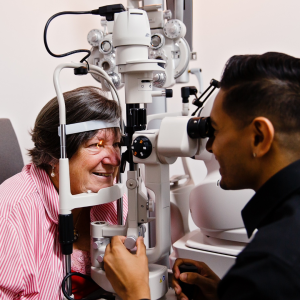Understanding Age Related Macular Degeneration
 Age-related macular degeneration (AMD) is a common eye condition that affects millions of people worldwide, particularly those over the age of 50. It is a progressive disease that damages the central part of the retina, known as the macula, which is responsible for sharp, detailed vision. The macula is essential for activities such as reading, driving, and recognizing faces. As a result, AMD can greatly impact a person’s quality of life, making it difficult to perform daily tasks and participate in social activities.
Age-related macular degeneration (AMD) is a common eye condition that affects millions of people worldwide, particularly those over the age of 50. It is a progressive disease that damages the central part of the retina, known as the macula, which is responsible for sharp, detailed vision. The macula is essential for activities such as reading, driving, and recognizing faces. As a result, AMD can greatly impact a person’s quality of life, making it difficult to perform daily tasks and participate in social activities.
Types of Macular Degeneration
There are two types of AMD: dry and wet. Dry AMD is the most common type and is characterized by the gradual breakdown of light-sensitive cells in the macula. This can cause blurred vision, difficulty seeing in low light, and the appearance of drusen (yellow deposits) in the retina. While dry AMD typically progresses slowly and does not cause complete vision loss, it can still significantly affect a person’s ability to see.
Wet AMD, on the other hand, is less common but more severe. It occurs when abnormal blood vessels grow under the macula and leak fluid and blood, causing damage to the macula. This can lead to rapid and severe vision loss if left untreated. Symptoms of wet AMD may include distorted or wavy vision, blind spots, and difficulty seeing colours.
 The exact cause of AMD is unknown, but age, genetics, and lifestyle factors such as smoking and poor diet are believed to play a role. Other risk factors include high blood pressure, obesity, and a family history of the disease. Unfortunately, there is currently no cure for AMD, but early detection and treatment can help slow its progression and preserve vision.
The exact cause of AMD is unknown, but age, genetics, and lifestyle factors such as smoking and poor diet are believed to play a role. Other risk factors include high blood pressure, obesity, and a family history of the disease. Unfortunately, there is currently no cure for AMD, but early detection and treatment can help slow its progression and preserve vision.
Regular eye exams are crucial for detecting AMD in its early stages. During an eye exam, your optometrist or ophthalmologist will perform a series of tests to assess the health of your eyes and check for any signs of AMD. These may include a visual acuity test, dilated eye exam, and imaging tests such as optical coherence tomography (OCT).
Treatment Options
Treatment options for AMD vary depending on the type and severity of the disease. For dry AMD, there is currently no cure, but certain lifestylechanges such as quitting smoking and eating a healthy diet rich in antioxidants may help slow its progression. Your optometrist may also recommend taking supplements containing vitamins and minerals that have been shown to benefit eye health.
Your optometrist may also recommend taking supplements containing vitamins and minerals that have been shown to benefit eye health.
For wet AMD, treatment options include injections of medication into the eye to stop the growth of abnormal blood vessels, laser therapy to seal leaking blood vessels, and photodynamic therapy to destroy abnormal blood vessels. These treatments can help prevent further vision loss and, in some
cases, improve vision.
The Importance of Regular Eye Exams

Regular eye exams are crucial for detecting macular degeneration early and managing AMD progression. They also help identify other eye conditions and risk factors that can contribute to macular degeneration. While there is no cure, early detection and treatment can help slow its progression and preserve vision. It is important to have regular eye exams and to make healthy lifestyle choices to reduce the risk of developing AMD. If you experience any changes in your vision, it is essential to consult with your Optometrist as soon as possible to determine the best course of action.
BOOK IN TODAY
https://eyesatoptometry.com.au









